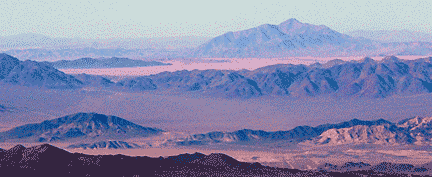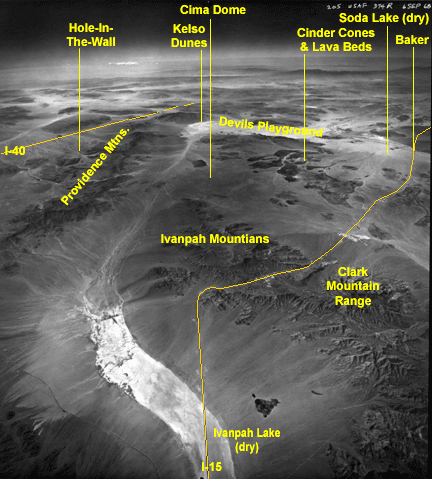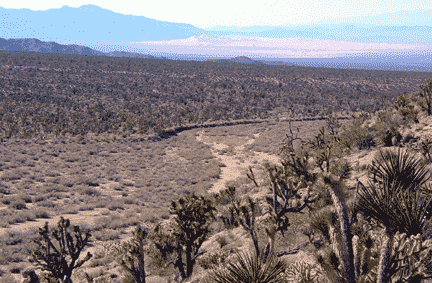Introduction to the
Mojave National Preserve
General Mojave
Geologic History
Changing Climates
& Ancient Lakes
Physiography
The Mojave Desert comprises the southwestern quadrant of the Basin and Range physiographic province, a vast region dominated by rugged mountain ranges and alluvium-filled basins that extends from northern Nevada to Mexico and from the California's Sierra Nevada and southern coastal region eastward to central Arizona and Utah. The Mojave Desert is transitional between the lower, hotter Sororan Desert to the south and the colder high desert of the Great Basin to the north. The Mojave Desert is characterized by extreme variations in daily temperatures and more arid conditions than other American desert regions. Freezing temperatures occur during the winter, particularly in higher elevation regions. Summers tend to be hot, dry, and windy. Average precipitation in the region is less than 12 cm, but is highly variable from one year to the next. Almost all precipitation arrives in the winter, but the region also experiences rare, intense summer thunderstorms. It is during these rare flood events that some of the most dramatic changes take place on the desert landscape.
The Mojave National Preserve encompasses an eastern portion of the of the greater Mojave Desert ecosystem region. The Preserve consists of nearly 1.6 million acres of varied landscapes including rugged mountains, canyons, volcanic fields, alluvial fans, dune fields, and dry lake basins. The U.S. Congress established the Mojave National Preserve in 1994 as part of the California Desert Protection Act.
Elevations in the Preserve range from the highest point, Clark Mountain (elevation 7929 feet; 2417 m), to a lowest elevation at Soda Lake (932 feet; 284 m). Other high upland areas include portions of the Granite, Providence, and New York mountains. Ecological habitats vary with the landscape and precipitation: pinyon-pine forests and frost-tolerant species occur above 5,500 feet (1675 m) where average precipitation is as much as 25 cm (some of which falls as snow); joshua-tree forests occur in the range of 4,000 to 6,000 feet (1220 to 1828 m); mixed desert shrub communities exist in the middle elevation regions and along the mountain range fronts, and; creosote bush and other drought-tolerant species survive in the lower elevation regions where rainfall averages less than 5 cm per year.
Mountains and Basins
Mountains impede travels across the desert, whether by pioneer wagon or sportscar. Likewise, the mountain ranges delineate the landscape and serve as barriers to the migration of sediments (carried both by water and wind). Adjacent to each range are corresponding valleys that are filled with sediments. The Mojave Desert region is within a great inland (isolated) drainage basin. Not for perhaps 10 million years have rivers consistently drained to the ocean! During the past Ice Ages, great lakes filled many of the lower valleys; many of these lake basins overflowed into adjacent valleys, and some eventually spilled into Death Valley. However, as with the current interglacial period, the region has dried up, leaving behind great dry lakebeds exposed to erosion by the wind. Between the ranges and the lakebeds are regions covered by coalescing alluvial fans (called bajadas) or extensive flat regions of barren, weathered bedrock (called pediments) where mountains probably once existed long ago but have long since worn away. The images below illustrate the "mountain and basin" character of the Mojave Desert region.
 |
|
This zoomed-in view is looking southwest along the Interstate 15 corridor from the top of Turquoise Mountain (just east of Baker, CA). The view incompasses portions of Silver and Soda dry lakes (near Baker in the foreground), the Soda Mountains across the middle, and the large, distant Cave Mountain. |
 |
| A high-altitude, oblique-view aerial photograph of the Mojave National Preserve region taken in September of 1968 with a view to the southwest. Note how the landscape is dominated by bajadas (coalescing alluvial fans) formed from the accumulation of sediments around erosionally dissected-mountain ranges. Ephemeral streams connect to dry lakebeds (playas) in the lowest valley regions. |
 |
| Cedar Wash cuts through a joshua tree covered landscape of a broad alluvial apron (a bajada) grading down slope from the Providence Mountains (left) to the main valley drainage, Kelso Wash (to the right). In the distance, Kelso Dunes blanket the valley beneath the distant high peaks of the Granite Mountains (upper left). Note the different color and texture of the broad wash - created by a different vegetation assemblage. |
Historic climate data for the Mojave National Preserve is scarce; no single weather station fairly approximates conditions throughout the region. Click here to see weather data (seasonal temperatures, precipitation, and wind) for selected weather stations in the region.

